Fishing Report: Jan. 28, 2022
Coldest air in years will impact Bay Area fishing
Cold air from Canada will push through the Bay Area’s Gulf coast this weekend and have a big effect on our local fisheries, says Captain Dylan Hubbard of Hubbard’s Marina. Fish will migrate into Tampa Bay as far as they can, looking for dark mud to stay warm. Hopefully, they do move, especially the snook, which are more of a tropical species and don’t do well in the prolonged cold. The post-cold front bite should get better mid-week while near shore, especially.
MADEIRA BEACH, Fla. - Every Friday morning, Captain Dylan Hubbard of Hubbard's Marina joins Good Day to fill viewers in on his fishing forecast as we head into the weekend.
Here is his fishing report for January 28, 2022.
Weather effects of fishing
We have a new moon coming up Tuesday and some extremely cold conditions with a big front moving through Friday night.
Behind the front, we have a high pressure settling in, allowing for a nice warming period. We should see a strong bite the first half of the week as the weather stabilizes some and we have a warm-up behind the extremely cold weekend.
LINK: FOX 13 weather forecast
The cold weather will drive a lot of our fish up into canals, creeks, rivers, and shallower waters on the flats. Afternoon periods will become a better time to get on the water as the sun has time to warm up some areas just enough to get fish moving and feeding.
Look for those wind-protected or sunbaked seawalls or coastlines. Deep pockets around shallow areas will hold the fish and the slowest possible movements on lures will be key.
Inshore
The redfish action this past week was steady around the area and many of the fish caught were hanging on those shallow water mangrove shorelines, grass flats, and around those sunbaked seawalls of the residential canals.
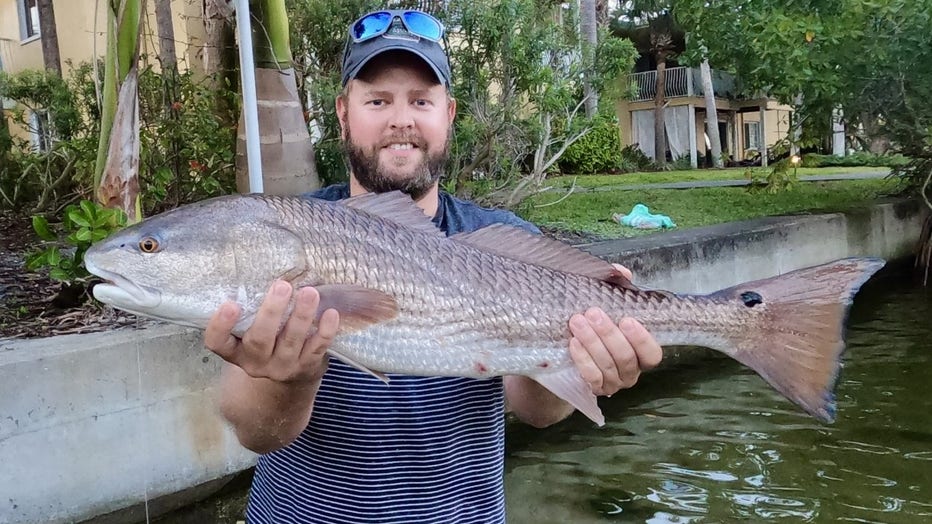
Redfish (Credit: Hubbard's Marina)
The dark bay mud located back in the residential canals and around the creeks, rivers, and mangrove shorelines radiates heat -- especially in the later afternoon once the sun has a chance to bake it a bit. All it takes is for that to warm up a few degrees more than the surrounding area, and it will attract and congregate bait, fish and produce a more active bite.
Extremely slow-moving soft plastics, swimbaits or artificial shrimp were good options this past week. Also, live shrimp is a great option when the water starts getting this cold. Finally, cut bait -- especially when the waters get murky and stirred up -- sitting on the bottom is an easy meal for a cold and lazy redfish or snook.
The snook action around the area has been a little more sporadic, but most concentrated back in the bay where they can find warmer, more consistent water temperatures. Hopefully, this weekend, a majority of our snook will make it back in the bay to these areas as they are very cold-water sensitive and can’t survive water temperatures that get too cool.
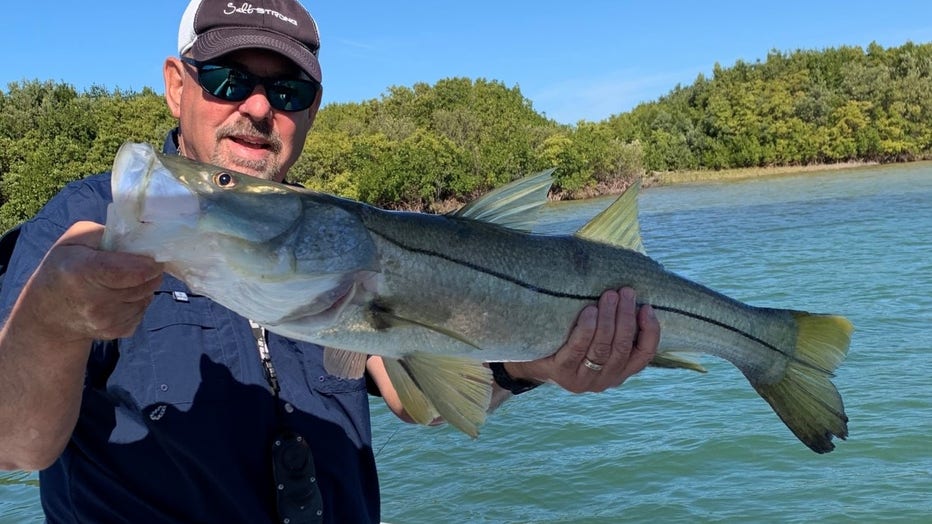
Snook (Credit: Hubbard's Marina)
Like the redfish, these guys are looking to find anywhere warmer to try and get some reprieve from cooling water temperatures. They are also moving slowly and looking for ways to eat without expending much if any energy.
Use live shrimp, cut dead bait, or those super slow-moving soft plastics with long pauses while working the lure across those pockets along shallow sun-drenched shorelines. Dock lines of residential canals are also hotspots as well as around dock lights at night. Keep in mind, those underwater lights, especially the older models, do radiate some heat and that’s enough to excite and congregate predatory fish.
As of late, trout action in the bay has been spotty, to say the least. A lot of places are showing signs of very weak trout numbers when we would expect heavy populations and good numbers and great action.
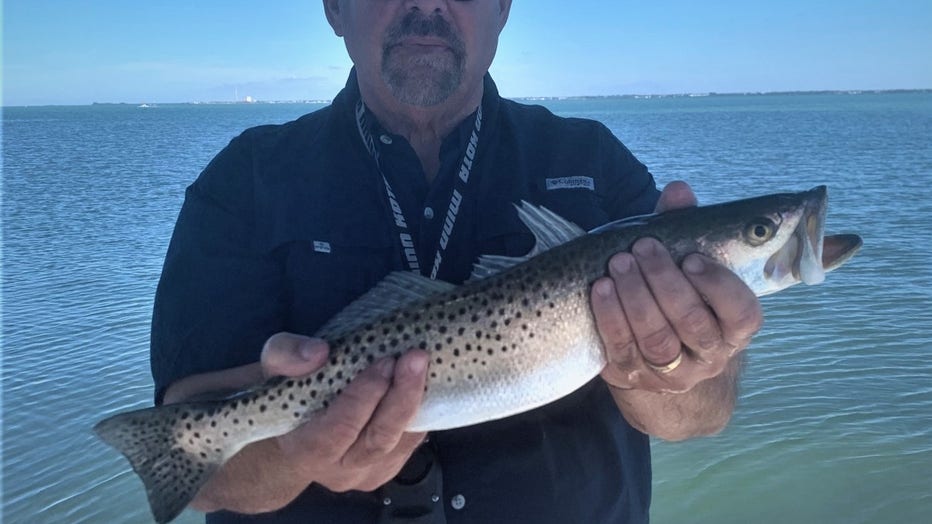
Trout (Credit: Hubbard's Marina)
This is the time of year when we should be seeing endless trout over the grass flats -- especially post-cold fronts in shallower flats. However, we just don’t seem to have the concentrations of fish we would expect to see this time of year. You are able to find them but much trickier to find high numbers of actively-feeding fish.
Also, you’re much more likely to find them in areas that weren’t hard hit by that recent red tide event.
Flounder action has picked up a bit around the area. We are seeing these guys around the flats, often in patches, potholes, and on the edges. Plus, they are around local structures like docks, piers, bridges, and jetties hanging on sandy bottom areas just waiting to ambush passing baits. Look for them with live shrimp, mud minnows, or slow-moving soft plastics on or near the bottom.
Near shore
The hogfish bite has been going well for us around the near shore waters, fishing anywhere from around 40 feet up to around 90 feet. We are catching them still most often using the live shrimp and lighter 30lb leaders and minimal weights with around 3-4ot hooks.
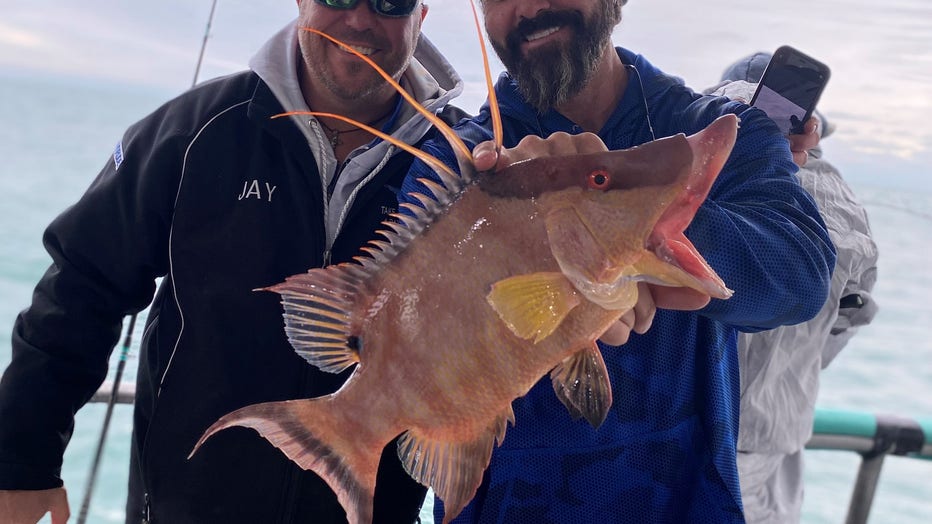
Hogfish (Credit: Hubbard's Marina)
However, some are getting them on even heavier tackle, especially with the more stirred up waters this makes them much less leader shy and picky. Look for them on those smaller ledges, areas of hard bottom, and even that shell bottom adjacent to the ledges, rock piles, and hard bottom areas.
Lane snapper have been really thick lately around 70-100 feet of water near shore, but we are seeing them shallower too. However, the deeper you get, the more concentrated and prolific they get. We are catching them most often on squid, shrimp, and small pieces of threadfin on lighter tackle.
Mangrove snapper have been consistent near shore lately out deeper like the lane snapper, however, like lane snapper we are seeing them here and there shallower but if you can get out there to more like 80-100 feet we are seeing much more steady and bigger fish.
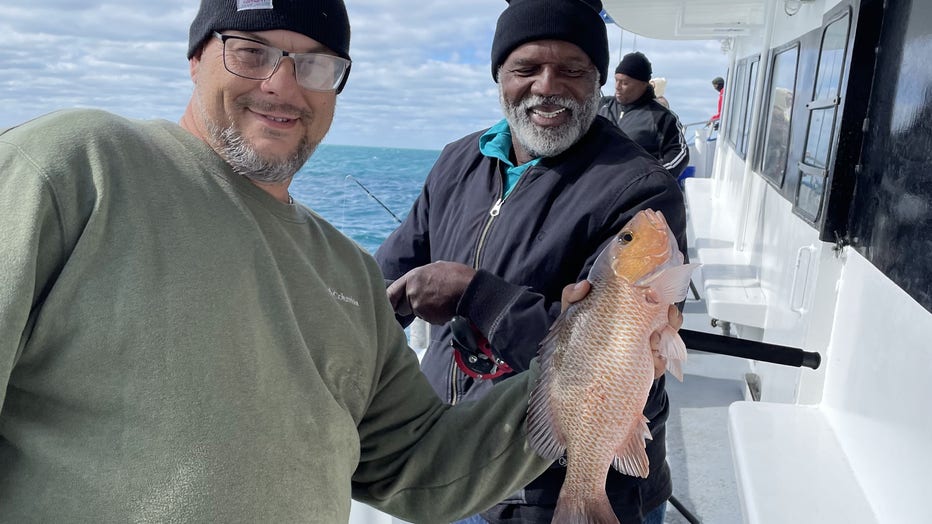
Mangrove snapper (Credit: Hubbard's Marina)
Some mangroves near shore closer to 100 feet are as big as 6-7 pounds which is extremely large for our near shore waters. Not a ton of them, but we are seeing a much larger overall size right now. Plus, the more stirred up conditions are making them more aggressive and much less leader shy and picky.
Red grouper action has been spotty near shore, but we are finding them here and there in the deeper near shore waters around the lanes and mangrove depths. However, they are not super prolific until we get offshore into much deeper waters.
The ones we are finding are biting on the squid strips, whole threadfins, or the live pinfish. Occasionally, you will get one on shrimp or smaller cut bait but most often it’s the undersized versions using smaller baits.
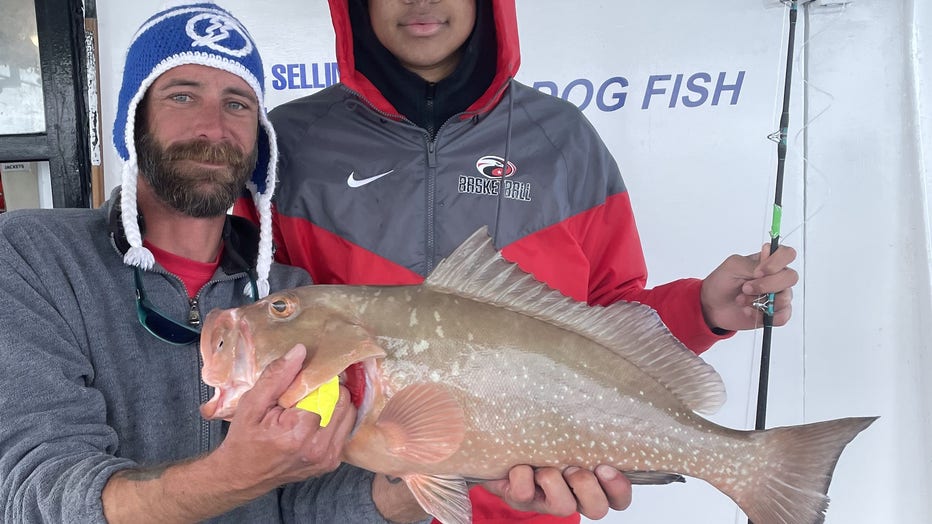
Red grouper (Credit: Hubbard's Marina)
Offshore
We were unable to get offshore into the deeper waters this past week with weather conditions. However, we know those fat red grouper are thick out there around that 100-120 feet mark. That’s where we will be focused in the coming two months with the deep-water grouper spawning closure.
For February and March, we are unable to keep any grouper species if you’re beyond the 20-fathom closure line, which is 120 feet of water. This means, often we will fish beyond 120 feet of water to start trips like our 39-hours or 44-hours to get the mangrove snapper at night.
Then, we would bounce in shallower areas for the sunrise and daytime fishing inside the ‘fence.’ That’s where we are able to keep those red grouper fishing 100-120 feet of water for the remainder of the trip.
Keep in mind, you can fish deeper than the ‘fence’ or closure line, but you cannot have any grouper on your boat when out there. So, if you want to fish deeper, start there -- not keeping any grouper and then bounce shallower to try to target and keep those red groupers and scamp grouper.
The pelagic bite has been a little soft lately due to stirred-up water conditions. However, if we get some reprieve from that offshore, the blackfin tuna bite should be extremely hot this time of year especially around this new moon with lots of currents moving, bait moving, and lots of muddier waters.
Don't be a fool; bring a venting tool and/or a descending device
It is so important to keep in mind the importance of dead discards and discard mortality when engaged in near shore or offshore fishing. If we can all work together to change the cultural norms near shore and offshore, we can all help to improve our fishery and our fishery access over time.
How many do you know right now that are all for catching and releasing snook, redfish, and trout but will be the first in line to kill a mangrove snapper, gag grouper or red snapper and the attitude completely changes when discussing these offshore species?
Plus, the same person inshore that will hold their breath and wet their hands before handling a breeder snook will go offshore and then cull through 20 red snappers before keeper their two red snapper they deem large enough to fill their two-fish bag limits while the other 18 they released will often end up suffering fatal damage if not properly descended or vented?
Please help us to spread the word on the importance of descending or venting your released fish. Descending devices are most easy to use and quick to pick up on their use and are most effective for most anglers. However, an expert and precise angler with proper training and tons of experience can use a venting tool properly with similar outcomes. However, a venting tool requires you to pierce the fish while most descending devices are much less invasive.
While using a venting tool it is imperative you pierce them in the exact right spot, and you do not go but a quarter-inch or less in the fish. Most venting tools require you to ‘choke up’ on the tool to prevent over-penetration into major organs.
When fishing deep water, especially in the sweltering summer months, please make sure to treat all fish intended to be released like that breeder snook inshore and minimize the time it takes you to get him from the bottom to the boat using heavier proper tackle not an ultra-light spinning reel. Then once onboard, minimize the time out of the water. Then use a proper dehooking tool, and then for the love of God, use a descending device or venting tool PROPERLY to ensure that fish has a chance to live another day.
Three things will help ensure the survivability of those fish released offshore.
- Making sure they are brought up quickly and do not expend all their energy in the fight.
- Make sure they are unhooked smoothly, easily, and as quickly as possible.
- Finally, make sure they spend the least amount of time at the surface at negative pressures where barotrauma exponentially increases its effect with each passing second.
Also, keep in mind when the water is warm there is less dissolved oxygen content, and the chances of barotrauma increase even more while its effects can be even more deadly.
CHECK OUT THE NEW WEBSITE and marketing campaign to get your own FREE descending device and more information on mitigating barotrauma and barotrauma issues! Do not forget to use the hashtag #ReturnEmRight to help spread the word too on fish you catch and release offshore -> https://returnemright.org/
State survey to improve recreational data and access
It is imperative that you have your gulf reef fish survey endorsement on your fishing license if you are a private recreational angler or diver fishing from a private boat anywhere in Florida who intends to harvest, attempt to harvest or possess one or more of the following reef fish species: mutton snapper, yellowtail snapper, hogfish, red snapper, vermilion snapper, gag grouper, red grouper, black grouper, greater amberjack, lesser amberjack, banded rudderfish, almaco jack, gray triggerfish, Gag grouper, Red grouper, Scamp grouper, Mangrove snapper, Lane snapper, Kingfish, Tuna, or Mahi mahi.
Here is all the information and more on that program and how you can sign up -> https://myfwc.com/fishing/saltwater/recreational/state-reef-fish-survey/
TERMS OF REFERENCE:
INSHORE – from the back bays out to the bridges and including right on the beaches
NEAR SHORE – From the beaches out to 20 miles, or up to 100ft of water
OFFSHORE – from 20 miles or 100ft and beyond
For more fishing reports, photos, videos and more check out Hubbard’s Marina on Facebook, Instagram, YouTube, or Snapchat. Just simply search "HubbardsMarina" and do not forget our family motto, "If you’re too busy to go fishing, you’re just too busy!

